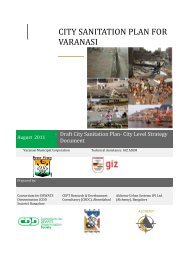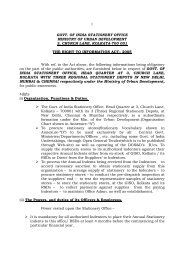CITY SANITATION PLAN - Ministry of Urban Development
CITY SANITATION PLAN - Ministry of Urban Development
CITY SANITATION PLAN - Ministry of Urban Development
Create successful ePaper yourself
Turn your PDF publications into a flip-book with our unique Google optimized e-Paper software.
<strong>CITY</strong> <strong>SANITATION</strong> <strong>PLAN</strong> BAREILLY<br />
enough to bring homogenous development in new areas. The growth <strong>of</strong> housing stock is not able to<br />
keep pace with the population growth. This has increased the housing stock deficit which has given rise<br />
to slum dwellings.<br />
As per the survey conducted by DUDA and documents from NNB, total notified slums in Bareilly are 85.<br />
According to census 2001, the slum population was 77109 i.e. 20.5 percent <strong>of</strong> total Population. As per<br />
the survey conducted by S.U.D.A in 2000-01, the population was 77109 and total households were<br />
10050. A large number <strong>of</strong> below poverty line (BPL) population (about 25%) also live-in slums. The<br />
current slum population is about 2.44 lacs with 31850 <strong>of</strong> households i.e. about 26.47% <strong>of</strong> the total<br />
population.<br />
ULB Pr<strong>of</strong>ile Year 2001 Year 2010<br />
Slum Population 77109 244373<br />
Slum Households 10050 31850<br />
No. <strong>of</strong> slums 85 85<br />
Water Supply Facilities: It may be seen that in slums access to individual water connections is low and<br />
people generally use public stand posts, hand pumps, or wells in a few cases. Majority <strong>of</strong> households<br />
(55%) get water from public stand posts and only 19% percent have individual taps. It has been observed<br />
that main source <strong>of</strong> water supply in slum areas is hand pumps and wherever piped water supply is there,<br />
either supply is inadequate or it’s not regular or it’s very dirty. They are only able to use the water after<br />
carrying out the sedimentation and filtering. Out <strong>of</strong> total households in slum, about 30 percent have<br />
electricity whereas others use either kerosene, wood etc.<br />
Sanitation Facilities: Presently, access to sanitation services is markedly less than access to other basic<br />
services. While, it may be worthwhile to note that the proportion <strong>of</strong> people having access to sanitation<br />
in urban areas is considerably greater when compared to their rural counterparts, the problems are<br />
more exacerbated in slums. <strong>Urban</strong> sanitation is perceived as being important because <strong>of</strong> the health<br />
ADMINISTRATIVE STAFF COLLEGE OF INDIA, HYDERABAD Page 32
















